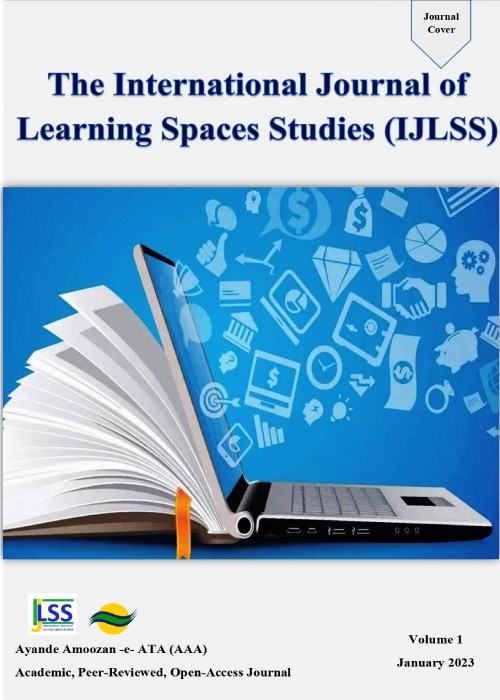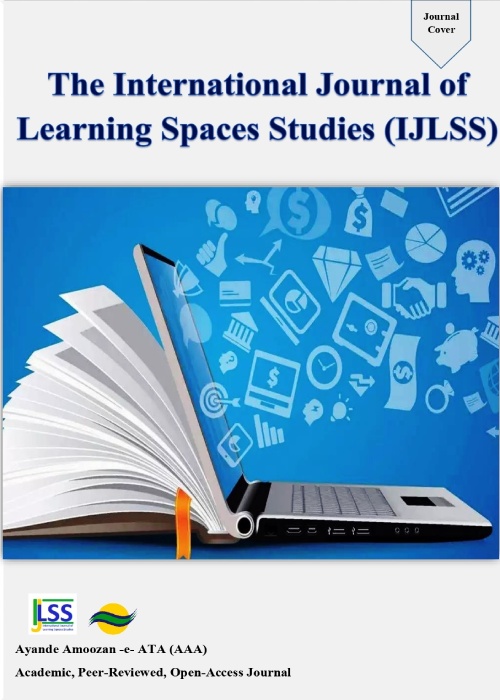فهرست مطالب

International Journal of Learning Spaces Studies
Volume:1 Issue: 1, Autumn 2022
- تاریخ انتشار: 1401/09/10
- تعداد عناوین: 6
-
Pages 1-8PurposeThis research aims to compare the effects of the flipped learning method based on Merrill's model with the conventional teaching methods on the academic performance of fifth-grade students in mathematics education.MethodThe statistical population of the research is all the fifth-grade students of the primary school in Islamshahr, Tehran, during the academic year 2018-2019. The data were through convenient sampling from students. The research method is quasi-experimental with a pre-test and post-test design. Pham and Taylor's standard academic performance questionnaire (1999) was used as a measurement tool. The face validity of the tool was confirmed by experts in educational sciences and specialized teachers of mathematics, and its impact score was reported as 2.3, and the reliability of 0.72 was obtained using Cronbach's alpha. The data were analyzed using one-way ANCOVA and paired t-tests.FindingsThe results showed that the flipped method designed based on Merrill's educational model had a greater impact on students' academic performance than its reported results in the literature. The implemented flipped method also affected students’ academic performance greater than the general conventional methods. In general, the findings indicate that teaching in the flipped method according to Merrill's design has a greater impact on the academic performance of students in mathematics than its traditional versions as well as the regular lecturing methods of teaching.ConclusionIt is argued that teachers and educational designers can enhance the effects of Merrill's model by integrating it into the flipped method classroomsKeywords: Merrill’s Educational Design Model, Flipped classroom, Academic performance, Educational Design
-
Pages 9-23PurposeThe current research aims to model the acceptance of misbehavior by customers with an interpretative structural approach.MethodThis research was done qualitatively and quantitatively. Delphi technique is used in the qualitative part. The studied population was experts and professionals in the gold and jewelry industry in Iran. Using the snowball technique, 10 people were selected as samples. Using a semi-structured interview, effective factors have been identified. ATLAS TI and EXCEL software are used in this part. In the following, the model is presented using the interpretive structural model technique. Based on the ISM technique questionnaire, the opinions of 10 experts were collected. Finally, modeling has been done based on the interpretive structural technique. The statistical sample includes 25 experimental experts and theoretical experts.FindingsEvery customer interaction is an opportunity to build relationships with customers and earn their loyalty. Based on the Delphi technique, 17 criteria were identified. These 17 criteria are economic conditions, market conditions, seller conditions, store conditions, information technology, marketing, demographic factors, cultural and social conditions, acculturation, customer orientation, customer mobility and dynamics, business strategies, customer satisfaction, and word-of-mouth advertising. and profitability, customer loyalty, stability in customer relationships, and purchase intention.ConclusionIn the following, a pattern is designed based on the interpretive structural technique. The proposed template has 8 levels. By moving from the lowest to the highest level of the model, the highest degree of influence in components is determined.Keywords: Customer Knowledge, Customer Misbehavior Acceptance, Customer-Seller Interaction, Jewelry industry
-
Pages 24-42PurposeThe present article aimed to evaluate 3 mobile game-based learning games and propose a suitable evaluation model.MethodThe following games were utilized to evaluate games: farming simulator, tractor farm driver, and farm town. The appropriate evaluation method included 4 components of motivation, game environment, support, and Instructional design and the outcome of the model included learning and motivation.FindingsThe results obtained from experts’ and students’ analysis of the game support the correctness of evaluation results and the usefulness of the proposed model as a desirable model.ConclusionWe may conclude that the evaluation of the three games mentioned above indicates the fact that this model can be suitable for evaluating games, especially computer and mobile games.Keywords: Mobile learning, Game-Based Learning, Instructional Design, evaluation model
-
Pages 43-49Purpose
The aim of the current research is to plan virtual learning lessons based on Acker's model. Virtual education is generally the use of web and internet technologies in education to realize effective learning. E-learning is one of these ways of providing higher education for its applicants, which has received a lot of attention today due to the increase in demand.
MethodIn this research, the research synthesis method with a qualitative approach has been used to examine the articles in the field of curriculum planning and e-learning. 30 articles were reviewed and coded in Nvivo software. Finally, an electronic learning model is proposed based on the 10 elements of Ecker's educational planning.
FindingBased on the obtained results, the most important aspect of e-learning is to bring the classroom time to life for the teacher; therefore, it increases the engagement of learners with the content, improves the interaction between the instructor and the learner, and enhances learning.
ConclusionIn a general view, in this method, the preparation and role of the teacher to implement this method are more difficult and time-consuming than the traditional method; However, the instructor has freedom of action in adopting the implementation methods of this method and according to the facilities, purpose, type of content and audience level, he can use all kinds of teaching-learning activities; In addition, there are obstacles in this approach, such as the universal commitment to accept the responsibility of learning, the type and quality of interactions, and the readiness to face educational materials.
Keywords: Virtual Education, Curriculum Planning, Acker Educational Model -
Pages 50-57PurposeThe present research was conducted with the aim of determining the effectiveness of thinking and lifestyle lessons on the academic resilience and creativity of secondary school (first) female students in Tehran's fourth education district.MethodThe research method is semi-experimental with two experimental and control groups, pre-test and post-test were conducted. The statistical population includes all 7th-grade female students of Tehran's Chahar district. According to the size of the population of one of the 7th-grade schools in Region Four, one school was determined as the statistical population in the current research. From the selected school, two 7th-grade classes were selected as a statistical sample. 64 students in two groups of 32 (experimental and control groups) were determined as the sample size. The data collection tool includes Samuels' academic resilience questionnaire (2004) and Torrance's "Abadi" creativity questionnaire (2012). After collecting information through the questionnaire, SPSS software was used to analyze the statistical data. A valid Kolmogorov-Smirnov test was used to check the normality of the distribution of main variables. Appropriate statistical tests such as the T-test, analysis of covariance, and ANOVA were used to analyze the data at an inferential level.FindingsThe results indicate that the lesson on thinking and lifestyle is effective on the academic resilience and creativity of female secondary school (first) students.ConclusionTo achieve this goal, it is necessary to invest in the most influential group of society, i.e., children and teenagers, because the beginning of curiosity and creativity in children is stronger than in all age groups, and no matter how large their environment is, they are rich information sources.Keywords: Lesson of Thinking, Lifestyle, academic resilience, creativity
-
Pages 58-68PurposeIn this context, the current research has sought to identify the state of application and training of fair valuation accounting in banks with a qualitative approach. In this perspective, the impact of fair value accounting on the efficiency of banks is useful in making policy decisions in order to maintain the stability of the financial system through healthy banks.MethodUsing a systematic review approach, the researcher analyzed the results and findings of previous researchers and identified the effective factors. 39 articles were selected in reliable databases.FindingsThe identified categories are: the main criteria are flexibility, supervision, rules and regulations, organizational conditions, knowledge and training, government factors, needs assessment, economic growth, and performance transparency; Therefore, by combining these 9 criteria, all of which have certain sources and repetitions, it is possible to identify these conditions, therefore, to study how to implement fair value accounting methods on the efficiency of banks in different stages of the business cycle or economic conditions for policymakers to understand the health of banks as well as stability.ConclusionThe financial system is essential. If fair value accounting practices improve banks' efficiency relative to historical cost principles, the additional improvement created by using unrealized gains can be used to generate higher returns on banks' credit portfolios. Credit growth depends on the capital level of each bank.Keywords: Fair Valuation Accounting Education, Bank Efficiency, financial stability, Credit Portfolio of Banks


